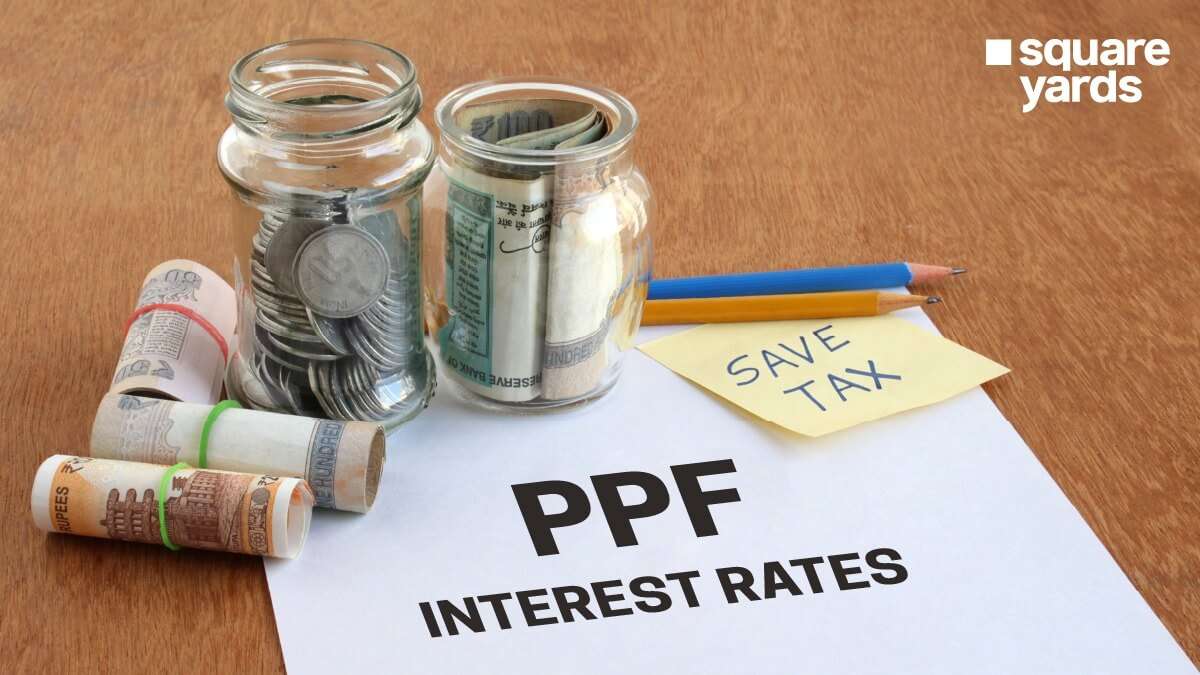The PPF interest rate is an important component of maintaining individual cash and operational expenses. Some owners are frequently baffled and concerned about EMIs. However, the payment can be easily computed and scheduled.
PPF is a decent choice for long-term investment. Not only can you get tax benefits, but you may also build an endowment of Rs 1 crore or more using PPF. This article explains how to open a PPF account, the documents required, its features, and so on.
Table of contents
- PPF Interest Rate
- Current PPF Interest Rate
- Eligibility to Invest in PPF
- Last 5 Years’ PPF Interest Rates
- Other Vendors of PPF Interest Rate
- How to Calculate PPF Interest Rate
- Consequences after the Death Account Holder on the PPF Account
- Interest on PPF Account for Minors
- Interest on PPF Account for NRI
- Features
- To Sum Up
- Frequently Asked Questions (FAQs)
PPF Interest Rate
The Public Provident Fund (PPF) programme is a long-term investment plan with a competitive interest rate and profits for shareholders. The interest and profits gained are not chargeable under the Income Tax Act. Under this system, one must register a PPF account, and the money contributed throughout the year will be returned as a deductible of 80C.
| PPF (Key Information) | |
| Rates of Interest Interest of Rate | 7.1% /annum |
| Minimum Investment Amount | ₹500 |
| Maximum Investment Amount | ₹1.5 lakh/annum |
| Total Tenure | 15 years |
| Profile of Risk | Offers guarantee offers during tenure and free risk returns |
| Benefit of Tax | Under section 80C, you will get ₹1.5 lakh |
Current PPF Interest Rate
The present PPF interest rate is 7.1% per annum. The Finance Ministry sets the interest rate, which is expected to be paid on March 31st every year. The rate is calculated on the lower interest rate between the fifth and last days of each month.
Eligibility to Invest in PPF
- Any Indian citizen can invest in PPF.
- PPF accounts are not available to NRIs or HUFs. If they already have a PPF account in their names, it will stay operational until the end of the year. However, unlike Indian nationals, this account could be maintained for another five years.
Last 5 Years’ PPF Interest Rates
The below table presents the PPF interest rate that has changed over the previous decade:
|
Time Frame |
Year | Interest Rate on PPF(%) |
| April to June | 2022 | 7.10% |
| January to March | 7.10% | |
| October to December | 2021 | 7.10% |
| July to September | 7.10% | |
| April to June | 7.10% | |
| January to March | 7.10% | |
| October to December | 2020 | 7.10% |
| July to September | 7.10% | |
| April to June | 7.10% | |
| January to March | 7.90% | |
| October to December | 2019 | 7.90% |
| July to September | 7.90% | |
| April to June | 8% | |
| January to March | 8% | |
| October to December | 2018 | 8% |
| July to September | 7.60% | |
| April to June | 7.60% | |
| January to March | 7.60% | |
| October to December | 2017 | 7.80% |
| July to September | 7.80% | |
| April to June | 7.90% | |
| January to March | 8.00% |
Other Vendors of PPF Interest Rate
The table shows the other vendor’s PPF Interest rate:
| Investment Names | Interest Rate | Time period |
| Public Provident Fund | 7.10% | 15 years |
| National Saving Certificate | 6.80% | 5 years |
| Tax Saver Fixed Deposit | 3.5-7.5% | 5 years |
| Sukanya Samriddhi Yojana | 7.60% | 21 years after the date of opening a bank account for the account holder’s marriage, whichever comes first. |
| 5-year Post Office Time Deposit Account | 6.70% | 5 years |
How to Calculate PPF Interest Rate
From the 5th to the last day of every month, the PPF fee is calculated on the low bank account. The profits on the PPF balances are computed using the current PPF interest rate. The whole interest generated in a financial year is deposited into the PPF balance at the end of the year.
For instance, if your PPF bank balance is ₹20,000 on April 1, 2021, and you invest ₹40,000 on April 8, 2021, your April payment will be determined at ₹20,000 rather than ₹60,000.
Nevertheless, if you invested the same amount on April 4, 2021, you would get ₹60,000 in return.
Consequences after the Death Account Holder on the PPF Account
In the event of the death of a PPF account holder, the nominees should have the account changed to their name. It is important to understand that a nominee is not permitted to contribute to the PPF account interest rate. If the money is not taken out before death, the bank will continue to receive a profit.
If the account owner has specified a certain portion to be allocated to each other, for example, 50% for each candidate, the bank will give it to the nominees. Nominees will hold the PPF money in confidence for the recipient’s beneficiaries.
Interest on PPF Account for Minors
Regardless of this fact, there are numerous tools on the market that can assist people in investing for their children’s future, such as bank loans, insurance, and even equities, fixed deposits, etc. However, these assets are very well suited for their inherent risk. The upbringing of their kids is among the most critical high-value expenses that parents should manage.
Parents and guardians can also open PPF funds in the place of their underage children. Nevertheless, the highest amount which can be given in a financial year is ₹1.5 lakh on both accounts, child and adult.
For example, a father cannot deposit ₹1.5 lakh in his account as well as another ₹1.5 lakh in his daughter’s accounts due to account guidelines. Moreover, he might put ₹90,000 during his PPF account and ₹60,000 in his daughter’s account. A minor’s PPF funds will earn the same interest rate as an adult’s PPF funds.
Parents must enrol in services with a guaranteed return. The Public Provident Fund (PPF) is a loan vehicle that offers financial benefits, a fixed rate of return, and a range of other perks. Minor PPF payments can be made at a post office, or a major bank authorised to open PPF funds, such as the State Bank of India (SBI).
Eligibility and Documents Required
- KYC (the guardian).
- Recent photographs of the minor.
- Identity and age proof, such as an Aadhaar card or birth certificate, of the minor.
- A minor’s PPF accounts can only be maintained by a parent or legal guardian till the child reaches adulthood, age 18 years.
Interest on PPF Account for NRI
An NRI doesn’t have permission to open a PPF account in India because he/she is not a resident of the country. A resident Indian, on the other hand, can create a PPF account and later become an NRI. This person can keep the account open until it matures.
If an NRI continues to pay into the PPF without informing their banks of their changed status, it will be treated as if they were an Indian resident instead of a non-Indian resident. After the maturity date, no interest is payable on the deposits. All banks keep a close eye on KYC documents, which notify them of the consumer’s residency status.
Features
- The PPF interest has a minimum period of fifteen years, which can be prolonged in 5-year increments if desired.
- Every financial year, PPF permits a minimum deposit of Rs 500 and a maximum deposit of ₹1.5 lakh. Investing can be done in a flat sum or over a period of up to 12 months.
- The PPF account interest rate can be started only with Rs 100 as a beginning balance. An investment of more than Rs 1.5 lakh per annum would not earn interest and therefore would not be subject to tax benefits.
- Investments into a PPF account must be made at least once a week for a period of 15 years.
- Deposits can be made in a PPF account via cash, check, demand draught (DD), or digital transfer of funds.
- A PPF account owner can select a nominee for their account either when the account is opened or later.
- A PPF account interest rate could only be kept in one person’s name. It is not possible to open a joint bank account.
To Sum Up
As we have explained in the blog, the PPF account interest rate can be used to generate money over time. Consumers who might not be insured by the Employees Provident Fund (EPF) can use the PPF as a long-term retirement income alternative. Everybody can open a PPF account with as little as ₹500 and deposit as much as ₹1.5 in a financial year. Even if you’re a regular employee, an owner of a small or large enterprise, and so on.
You must consider PPF interest that protects your difficult money while also providing excellent compounding annual growth.
Frequently Asked Questions (FAQs)
Is it required that the PPF account balance be withdrawn at the completion of the 15-year period?
You are not required to withdraw your PPF balance at the conclusion of the maturity term, which is 15 years. As long as you shut the account, you can leave the savings in the bank to earn interest.
What is the rate of return on a PPF for older people?
The interest rates on PPFs are always the same, even for senior citizens.
Is the interest from a PPF taxable?
No. Interest payments on a PPF deposit are tax-free while the PPF deposits are classified as exempt.
When a PPF account holder passes, how can you get your money back?
Form G can be used by the nominee to reclaim the PPF account. As a subscription must include the scanned copy of the death certificate, PPF cheque book, Declaration of Insurance, and testimony.







































